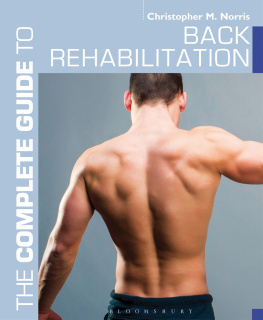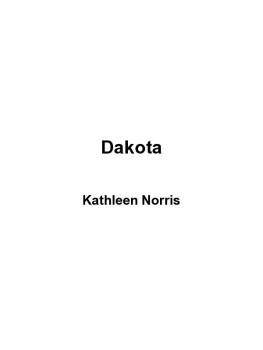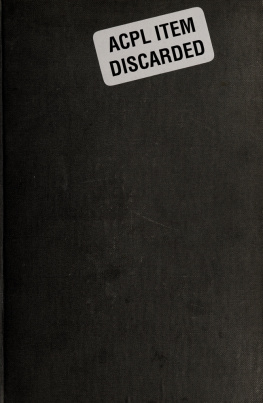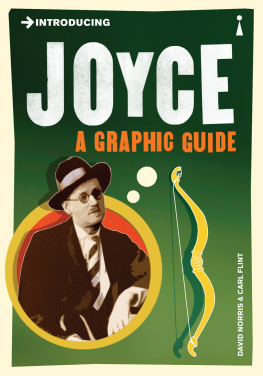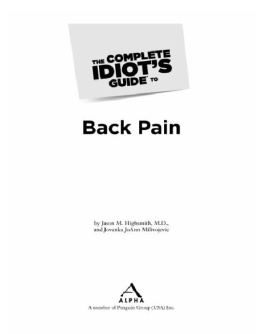Christopher M. Norris - The Complete Guide to Back Rehabilitation
Here you can read online Christopher M. Norris - The Complete Guide to Back Rehabilitation full text of the book (entire story) in english for free. Download pdf and epub, get meaning, cover and reviews about this ebook. year: 2015, publisher: Bloomsbury UK, genre: Home and family. Description of the work, (preface) as well as reviews are available. Best literature library LitArk.com created for fans of good reading and offers a wide selection of genres:
Romance novel
Science fiction
Adventure
Detective
Science
History
Home and family
Prose
Art
Politics
Computer
Non-fiction
Religion
Business
Children
Humor
Choose a favorite category and find really read worthwhile books. Enjoy immersion in the world of imagination, feel the emotions of the characters or learn something new for yourself, make an fascinating discovery.
- Book:The Complete Guide to Back Rehabilitation
- Author:
- Publisher:Bloomsbury UK
- Genre:
- Year:2015
- Rating:4 / 5
- Favourites:Add to favourites
- Your mark:
- 80
- 1
- 2
- 3
- 4
- 5
The Complete Guide to Back Rehabilitation: summary, description and annotation
We offer to read an annotation, description, summary or preface (depends on what the author of the book "The Complete Guide to Back Rehabilitation" wrote himself). If you haven't found the necessary information about the book — write in the comments, we will try to find it.
The Complete Guide to Back Rehabilitation — read online for free the complete book (whole text) full work
Below is the text of the book, divided by pages. System saving the place of the last page read, allows you to conveniently read the book "The Complete Guide to Back Rehabilitation" online for free, without having to search again every time where you left off. Put a bookmark, and you can go to the page where you finished reading at any time.
Font size:
Interval:
Bookmark:


This electronic edition published in 2015 by Bloomsbury Publishing Plc
Bloomsbury Sport
An imprint of Bloomsbury Publishing Plc
| 50 Bedford Square | 1385 Broadway |
| London | New York |
| WC1B 3DP | NY 10018 |
| UK | USA |
www.bloomsbury.com
Bloomsbury is a trademark of Bloomsbury Publishing Plc
First published 2015
Christopher Norris, 2015
[Illustrations Dave Gardner, 2015]
Christopher Norris has asserted his right under the Copyright, Designs and Patents Act, 1988, to be identified as Author of this work.
All rights reserved
You may not copy, distribute, transmit, reproduce or otherwise make available this publication (or any part of it) in any form, or by any means (including without limitation electronic, digital, optical, mechanical, photocopying, printing, recording or otherwise), without the prior written permission of the publisher. Any person who does any unauthorised act in relation to this publication may be liable to criminal prosecution and civil claims for damages.
No responsibility for loss caused to any individual or organisation acting on or refraining from action as a result of the material in this publication can be accepted by Bloomsbury or the author.
British Library Cataloguing-in-Publication Data.
A catalogue record for this book is available from the British Library.
Library of Congress Cataloguing-in-Publication data has been applied for.
ISBN: PB: 978-1-4081-8722-7
ePDF: 978-1-4729-1672-3
ePub: 978-1-4729-1671-6
Note
While every effort has been made to ensure that the content of this book is as technically accurate and as sound as possible, neither the author nor the publishers can accept responsibility for any injury or loss sustained as a result of the use of this material.
To find out more about our authors and books visit www.bloomsbury.com. Here you will find extracts, author interviews, details of forthcoming events and the option to sign up for our newsletters.
CONTENTS
HOW THE BACK WORKS
GENERAL DESCRIPTION
The spine is divided into five regions: cervical (neck), thoracic (mid-) and lumbar (lower), with the sacrum and coccyx forming the rudiments of the tail. The spinal column as a whole is made up of 33 individual bones (vertebrae). Each vertebra is numbered to show its position. Cervical vertebra numbers start with C, thoracic T, lumbar L and sacral S. So, for example, the second cervical vertebra counting down from the head is C2, and the fourth C4. The numbering system for every section begins at the head, so the last lumbar vertebra is L5. Note also that, until the 1950s, the Thoracic area was commonly called the Dorsal region, so old books or papers which quote them may use D instead of the T to denote this region. In addition to this, some traditional exercise organisations still use the term Dorsal in their teaching.
Key point
Vertebrae are numbered from the head down, with C1 just below the head and C7 between the shoulders.
STRUCTURE OF A TYPICAL VERTEBRA
A typical vertebra (see ) has an anterior (front) and posterior (back) part. The anterior portion consists of a large circular body flattened slightly at its back. This body is attached above and below to a spongy vertebral disc. The posterior portion of the vertebra forms an arch (called a neural or vertebral arch). This has a total of seven processes attached to it.

Figure 1.1 Structure of a typical vertebra
Definition
A process is a projection of bone that juts through the skin to form a small mound or knobble on the skin surface. Examples are found on several bones including vertebrae (spinous process), the radius (styloid process), and temporal bone of the jaw (mastoid process).
At the back of the vertebra is the spinous process, the tip of which can be felt with the fingers (this is made easier if the subject bends forward so that the skin is stretched tight). Jutting out at the sides are two transverse processes.
These form the attachment of muscles and are located approximately two finger widths from the centre line. They are covered by muscle and are thus harder to palpate (palpation is the practice of using ones hands to examine organs or other parts of the body). However, deep palpation can usually locate the transverse processes on a very lean subject. Just in front of the vertebral body is a hole called the vertebral foramen, which encloses the spinal canal. At the angle between the spinous process and transverse process is a shallow cup called the articular process, and there are four of these, two on each side, one above (superior) and one below (inferior). Each articular process is cup shaped and connects with a similar cup of the vertebra above and below to form a small flat joint on each side of the vertebra called a facet joint (also known as an apophyseal joint). The point at which the neural arch attaches to the vertebral body is called the pedicle and the point of attachment to the spinous process is called the lamina.
Definition
The spinal canal is the space in the vertebrae, enclosed by the vertebral foramen, through which the spinal cord passes.
Clinical note
In a operation called a Laminectomy a small piece of bone along the lamina is removed to provide more space around the notes. The operation is performed in cases of disc prolapse (slipped disc) and spinal stenosis (narrowing of the spinal canal). Laminectomy is a microsurgery procedure and often some ligament and other tissue will be removed at the same time.
Each pair of spinal bones together forms a single unit called a spinal segment (see how these joints can be injured or affected by medical conditions.

Figure 1.2 Spinal segment
Definition
A synovial joint is the most common movable joint in the human body. It consists of two bone ends covered by cartilage (hyaline cartilage). The joint is contained within a fibrous bag called the joint capsule, which is lined by a synovial membrane. The joint is lubricated by synovial fluid.
REGIONAL DIFFERENCES
). The lumbar vertebrae are large, strong bones covered with powerful muscles. They bear the whole weight of the trunk above them, hence the slightly stubby appearance of their spinous and transverse processes.

Figure 1.3 Differences in structure between typical vertebrae in each spinal region

Figure 1.4 Joints between the ribs and thoracic spine
CERVICAL REGION
The cervical region is subdivided into two functional parts. The upper portion directly below the head is called the
Font size:
Interval:
Bookmark:
Similar books «The Complete Guide to Back Rehabilitation»
Look at similar books to The Complete Guide to Back Rehabilitation. We have selected literature similar in name and meaning in the hope of providing readers with more options to find new, interesting, not yet read works.
Discussion, reviews of the book The Complete Guide to Back Rehabilitation and just readers' own opinions. Leave your comments, write what you think about the work, its meaning or the main characters. Specify what exactly you liked and what you didn't like, and why you think so.

